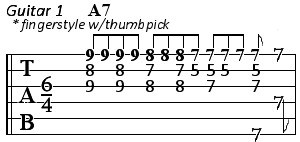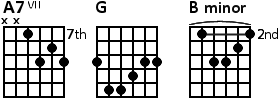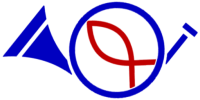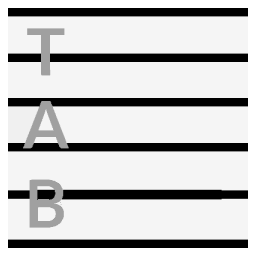
Tablature As Sheet Music
Unlike the normal musical staff which has 5 lines and four spaces, in string tablature there is one line for each string of the instrument. Numbers used as notes indicate the fret board fingering positions. String tablature is not only used with guitars but also for other stringed instruments including banjo, bass, cello, mandolin, and violin.
In string tablature we read the top line as the bottom string. If you know your instrument, then you understand why. Looking at the performer and their instrument, this appears to be opposite but from the performers view the fret board matches the sheet music when held in front of them.
Using numbers (numerals) as notes merely tells the string performer where to place their finger on the fret board. The numbers and positions give them a little more to think about while playing. Once the instrument is mastered, reading tablature is actually easier.

To the left is a short example of tablature as sheet music. As you can see in the illustration, the performer still has to read the sheet music normally in notes, rests, etc. Notice that there is no clef or key signature to indicate the instrument and pitch of the music. Since tablature is written for a specific instrument, the clef and key signature are not necessary. Also, if the music gives the exact finger positions, you don't need a sharp or flat sign on the note. The chord and/or key of the piece is often written above the measure as in the example.

Chord tablature is another form of string tablature which illustrates the instrument's fretboard. Dots indicate the fretboard fingering positions. The chord tab (short for tablature) or key of the composition is placed above the measure where the key begins or changes. Some sheet music merely indicates the chord for strings by writing the letter and/or numeral of the key or chord above the appropriate measure of the staff as in the example above.


